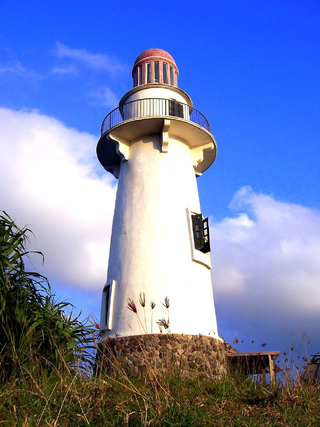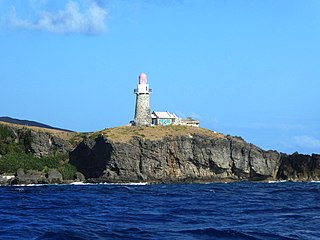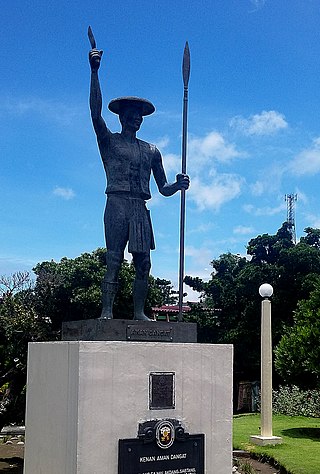
Batanes, officially the Province of Batanes, is an archipelagic province in the Philippines, administratively part of the Cagayan Valley region. It is the northernmost province in the Philippines, and the smallest, both in population and land area. The capital is Basco, located on the island of Batan.

Basco, officially the Municipality of Basco, is a 5th class municipality and capital of the province of Batanes, Philippines. In the 2020 census, it had a population of 9,517 people.

Batan Island is the main island of Batanes, an archipelagic province in the Philippines. It is the second largest of the Batanes Islands, the northernmost group of islands in the Philippines.

The Ivatan language, also known as Chirin nu Ivatan, is a Philippine language of Austronesian origins spoken in the Batanes Islands of the Philippines.

Itbayat, officially the Municipality of Itbayat,, is a 5th class municipality in the province of Batanes, Philippines. In the 2020 census, it had a population of 3,128 people.

Sabtang, officially the Municipality of Sabtang, is a 6th class municipality in the province of Batanes, Philippines. According to the 2020 census, it has a population of 1,696 people.

Uyugan, officially the Municipality of Uyugan, is a 6th class municipality in the province of Batanes, Philippines. According to the 2020 census, it has a population of 1,380 people.

Mavulis Island is the northernmost of the Batanes Islands and the northernmost island in the Philippines. It is part of the province of Batanes. The island is uninhabited but it is guarded by the military. It is also frequently visited by local fishermen for fishing adventures.

Basco Airport is an airport serving the province of Batanes in the Philippines. It is located in the provincial capital, Basco. It is one of two airports in the Batanes Islands, the other being Itbayat Airport.

Mount Iraya, is a dormant stratovolcano on Batan Island and the highest point in the province of Batanes, Philippines.

The Batanic languages are a dialect cluster of the Austronesian language family. They are spoken on Babuyan Island, just north of Luzon; three of the Batanes Islands, between the Philippines and Taiwan; and on Orchid Island of southern Taiwan.

The Ivatan people are an Austronesian ethnolinguistic group native to the Batanes and Babuyan Islands of the northernmost Philippines. They are genetically closely related to other ethnic groups in Northern Luzon, but also share close linguistic and cultural affinities to the Tao people of Orchid Island in Taiwan.

Sabtang Lighthouse is an active lighthouse in Sabtang, Batanes, Philippines.

Ivuhos is one of the islands of Batanes, the northernmost province of the Philippines. The uninhabited island is located west of Sabtang Island and is separated by a deep channel nearly 2 kilometres (1.2 mi) wide.

San Carlos Borromeo Church, also known as Mahatao Church, is a Roman Catholic church located in Mahatao, Batan Island, Batanes, Philippines. The church's titular is Saint Charles Borromeo whose feast is celebrated every November 4. Its beauty and excellent state of preservation made it a National Cultural Treasure by the National Museum of the Philippines on July 31, 2001.

Ijangs are the terraced hillfort settlements of the Ivatan people built on hill tops and ridges in the Batanes Islands of the Philippines. These high rocky formations can serve as fortress or refuge against attacking enemies for the Ivatan people.

Aman Dangat, also known as "Kenan", was a powerful Mangpus of the town of Malakdang in the island of Sabtang in Batanes, Philippines who had led a revolt against the Spaniards from 1785 to 1791.

Falua, also spelled faluwa, is a traditional open-deck boat of the Ivatan people from the islands of Sabtang and Batan in the Philippines. It is about 8 to 12 m long and has one mast. It can also be propelled by six to ten pairs of rowers. It can carry thirty passengers and is used to ferry goods between the islands. Modern falua are generally motorized. Falua is similar in shape to the chinarem but differs in that it is usually larger and has a flat transom.
Chinarem was a traditional open-deck boat of the Ivatan people from the island of Sabtang in the Philippines. It was around 6 to 8 m long with three or four pair of rowers and a single mast. It was similar to the falua in shape, but differs in that the stern was pointed. It can carry ten passengers and was generally used to ferry goods and people between the islands of Sabtang and Batan. Chinarem is extinct, it disappeared in Sabtang Island around the 1970s.

Tataya are traditional small fishing boats, with or without outriggers of the Ivatan people in the Philippines. They are generally round-hulled and powered by rowers or sails made from woven pandanus leaves. They have several variants based on size and island of origin. The term tataya can also be used for all traditional boats in the Batanes Islands in general, similar to the term bangka in the rest of the Philippines.




















